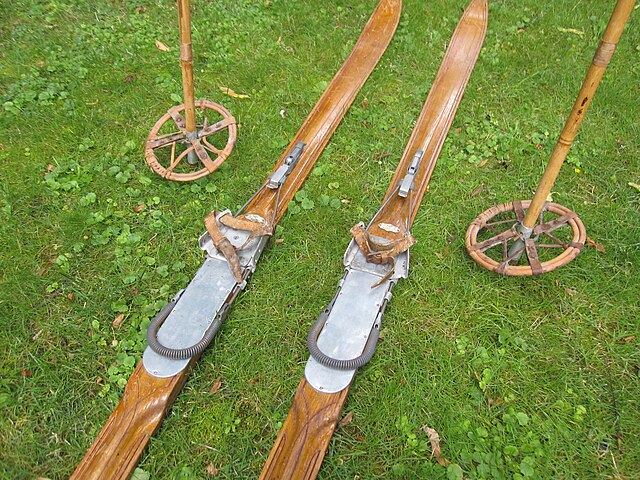Ski
Videos
Page
A ski is a narrow strip of semi-rigid material worn underfoot to glide over snow. Substantially longer than they are wide, and characteristically employed in pairs, skis are attached to ski boots with ski bindings, with either a free, lockable, or partially secured heel. For climbing slopes, ski skins can be attached at the base of the ski.

A shaped alpine ski with relatively little sidecut and classic camber: the tip and tail touch the snow while the midsection is in the air.

Old skis

Asymmetrical skis used by the Danish-Norwegian army in the 18th century, long ski for the right leg, also shown in profile (far left).

Wooden skis with cable (kandahar) bindings and bamboo poles
Ski boot
Videos
Page
Ski boots are footwear used in skiing to provide a way to attach the skier to skis using ski bindings. The ski/boot/binding combination is used to effectively transmit control inputs from the skier's legs to the snow.

A typical "universal" ski boot of the leather era. This example, by G. H. Bass, includes an indentation around the heel where the cable binding would fit, and a metal plate at the toe for a Saf-Ski release binding. The leather strap is a "long thong", used by downhill skiers to offer some level of lateral control.

A pair of modern front-entry alpine ski boots made by Salomon. As with almost all modern examples, four buckles are used to close the openings at the top of the foot and front of the leg to produce stiff cylindrical forms. Above the top buckle on the leg is the "power strap", which acts as a fifth buckle. The rivets forming the pivot points that allow the upper and lower portions of the boot to move independently are seen in silver.

Salomon's SX 92 Equipe was the penultimate development of their SX series of rear-entry ski boots. The boot on the left is in the "open" position.

Rosemount's side-entry design, circa 1968. The metal framework that provides forward flex is not visible in these images. The "crushed" section at the top of the boot is an elastic material that prevents snow from entering the cuff.